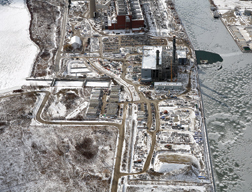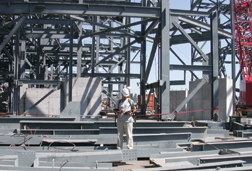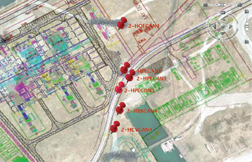...natural-gas combined-cycle powerplant at the Portlands Energy Center, for Ontario Power Generation, and TransCanada Energy, Toronto, Ontario. The crowded site has multiple remote laydown yards.

SNC-Lavalin Thermal Power RFID tag reception was not hampered by snow.
|
The pipe spools for the two boilers were fabricated in seven plants in Canada and Nova Scotia and are shipped mingled on trucks or ships. The practice is to sort and tag them on receipt, Murray says, but later he got one of his fabricators, W.S. Nicholls Industries, Cambridge, Ontario, to install tags at the shop.
Scott Kerr, Nicholls’ fabrication coordinator, says the batch his company tagged consisted of 80 pieces of 2-in.-dia. pipe in 6-ft to 40-ft lengths. He says the tags were fastened to flange holes with zip ties and were no bother. If their read range of about 10 ft had been more like 50 ft, he says he would use them to track components around his own yard. He adds that the read range probably would have been better had he not tucked the RFID tags inside the ends of the pipe to safeguard them from damage.

Bechtel/CII Research Team Bechtel’s trial focused on tracking steel for one of two identical structures.
|
The pipefitters union was consulted early, Murray says. “We walked the business manager through [the process], so they knew it was not a productivity tracking system in disguise,” he says. The union’s reaction has been positive. “Instead of having a $75-per- hour pipefitter go out and look for [a component], we had a $14-per-hour student intern ID it, and then they would go out and get it,” Murray says. “It prevented rework and allowed [supervisors] to plan better. The foremen love it.”
Murray says the read range of the tags is the biggest issue. “It was 50 meters—but it varied plus-or-minus 40 meters,” he says. “The transmission space on an industrial site like this is really flaky.” But snow cover, which can really make locating components difficult, was not a problem, he says. “That is why we are embracing this on our northern sites,” Murray adds.
First Focus
In pretest conferences between SNC-Lavalin and the researchers, a decision was made to focus on 224 critical pipe spools, 22 safety valves and 100 globe valves for one of the boilers using techniques and hardware similar to that used in the Texas trial. Both trials used “active,” or battery-powered, RFID tags that emit signals constantly, from IDentec Solutions Inc., Lustenau, Austria and Addison, Texas. The tags cost about $30 apiece. The data-collection devices varied from handheld computers to tablet PCs equipped with GPS and RFID receivers.
| + click to enlarge |
 CII SNC-Lavalin’s research partners plotted locations on demand.
|
Lead field researchers for the trials were Carlos Caldas, an assistant professor in civil engineering at the University of Texas at Austin, for the Rockdale trial, and in Toronto, Carl Haas, a civil engineering professor at the University of Waterloo in Waterloo, Ontario. A third lead researcher is Paul Goodrum, an associate professor in civil engineering at the University of Kentucky. Goodrum is working to establish a historic productivity baseline and methodology for predicting and measuring the effect of the introduction of new tools and technology to construction. Goodrum worked with Caldas and Haas to design the trials.
Field-data collection was handled by interns and graduate students. Ph.D. candidate Saiedeh Navabzadeh Razavi, who is working under Haas on applying artificial intelligence to the materials- tracking problem, works on software to convert the data into coordinates for display on Google maps. Her goal is to optimize the system by processing just enough data to do the job. “It is a trade-off,” she says. The goal is to come up with a location with the least amount of equipment using the least resources at the least cost, she explains. Her research is in developing software to collate multiple-read events picked up as handheld or vehicle-mounted receivers sense the tags. If the read range is 50 ft, each pass can be used to refine the location with greater certainty at no additional cost in equipment, she and others say.
The project originally was scheduled for the summer of 2007. “It was so successful, it was extended,” says Razavi. “They wanted to have it to the end of project.”
Razavi has worked on both sites. “The same as anything else—any other technology—there is still some other stuff to work on like integrating [the process] with other systems to make it more complete. But based on my experience and understanding, this is completely suitable for adoption,” she says.
Murray wholeheartedly agrees. “Carl [Haas] wanted me to prove [the technology] worked, and I just went on and used it,” he says.

Post a comment to this article
Report Abusive Comment